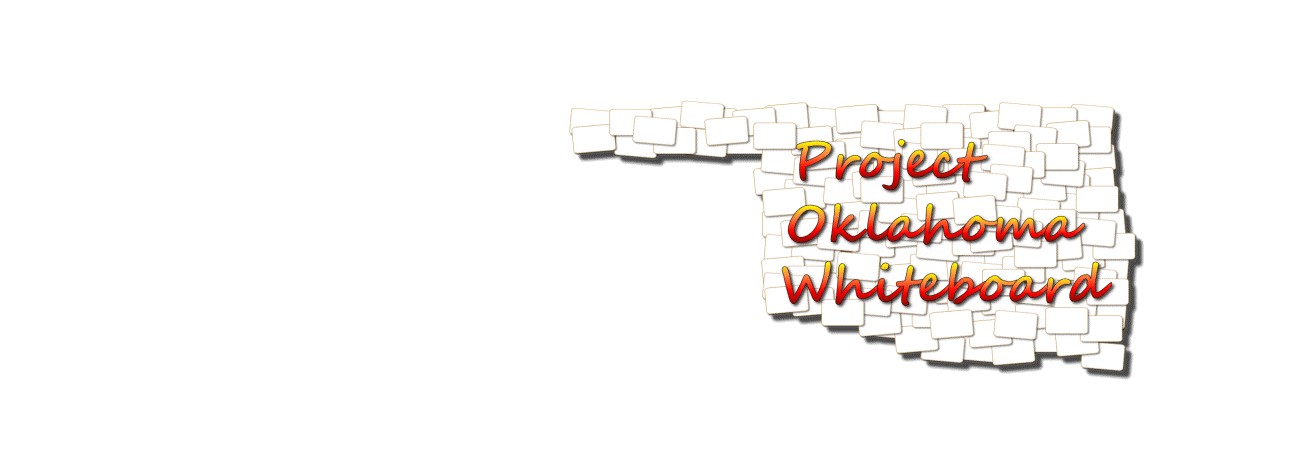
School of Arts & Sciences
Project Oklahoma Whiteboard
Contact:
Steven J. Maier
sjmaier@nwosu.edu
Just What is Project Oklahoma Whiteboard?
Project Oklahoma Whiteboard was an initiative to promote active learning in the classroom by getting class sets of whiteboards in as many Oklahoma science classrooms as possible. By providing examples of their effective use, related resources, and supporting research-based documentation, our hope was for classrooms across the state to give this versatile education tool a try!
At the beginning of the 2012-2013 academic year, every active High School physics teacher in the state were sent a set of 25 whiteboards (9" x 12") at no charge and with no obligation.
Included in each Project Oklahoma Whiteboard package included:
- Information on the AAPT/PTRA ToPPS Program at NWOSU
- An AAPT membership application
- Physics First Informational packet
- AAPT calendar
- AAPT HS Physics photo contest poster
- Information on the AOK section of the AAPT (search AOK - American Association of Physics Teachers on Facebook)
- Example "best practice" activities to get started using whiteboards (via this website)
- A list of practitioner and research-based resources available on the web for using whiteboards in the classroom (via this website)
Why Whiteboards? What's all the fuss about?

Near the close of the 2011 AAPT/PTRA NWOSU ToPPS grant cycle, some discussion began about what kinds of "takehome" items could have the greatest impact for participants and their students. While higher end technology items were considered, some realizations about science teachers were identified:
- Most science teachers teach more than one subject/discipline
- Some science teachers are more proficient with technology than others
- Some science teachers use data acquisition materials, but not all
- Availability to IT within a district is not consistent across the state
- While data acquisition interfaces are nice, only one unit for a class of 25 - 30 is impractical and let's face it, probe/sensors are expensive
During the 2011 NWOSU ToPPS program, participants made regular use of "no frills" whiteboards. Recalling this, we determined this could have the greatest impact given the demographics of our ToPPS participants and Oklahoma's science teachers -- despite it's "low technology."
The PI for this project is Steven Maier, Professor of Physics at Northwestern Oklahoma State University. Significant contribution toward the project is from Brian Lamore, a PTRA from Houston, TX -- Thank You, Brian! Funding is made possible through Title II grants awarded by the Oklahoma State Regents for Higher Education.
How to "Whiteboard"
Just as there are numerous ways to facilitate learning in the classroom, there are numerous ways to effectively use whiteboards in the classroom.
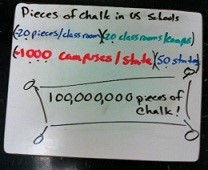 For those new to the idea of using whiteboards in the classroom, here are some suggestions to get started. These only scratch the surface, though. Browsing the resources on these pages and the web will quickly reveal depths of usage that have more to do with pedagogy than writing on a whiteboard.
For those new to the idea of using whiteboards in the classroom, here are some suggestions to get started. These only scratch the surface, though. Browsing the resources on these pages and the web will quickly reveal depths of usage that have more to do with pedagogy than writing on a whiteboard.
1. Just getting started? Give each student a small whiteboard & marker, then ask a question. Have them work a problem or draw a diagram. When done, select students at random to explain their work. Or, select boards at random and point out strengths of work and common difficulties. Pictured to the right is a simple Fermi estimation question: "estimate how many pieces of chalk there are in US schools."
2. Want more interaction? Give each student a small whiteboard & marker, then ask a question. Just a couple minutes in, tell students to switch whiteboards with their neighbor and finish what their neighbor started without erasing the original work. Then have them share what they added and what they think their neighbors' thought processes were.
3. Group work? Give each student group a large whiteboard (or, have students create a larger area by putting their individual boards together). Then ask a question for the group to work on together. When done, have the group members circle what they think are the three most important things they wrote down.
4. More group interaction? Combine 2 and 3 above! Have groups exchange boards and evaluate the others' work or circle the three most important things. Then in a class discussion, see if the authors agree with what the other groups said.
5. Into classroom polling? You can use whiteboards as a low tech clicker. Just ask a question, have the students "select" their answer by writing it on the whiteboard in big font. Have them reveal their answers all at once.
Small Whiteboard Discussion Wiki
This wiki is a forum that discusses the role a small whiteboard could play in the classroom. Like any tool, it can serve only as a superficial novelty, . . . or as a pivotal tool that really draws students in, keeping them engaged and on task. Thank you Mary Bridget for this link!
Here's a whiteboard gem: ask students to draw what they think is going on inside a magnet.
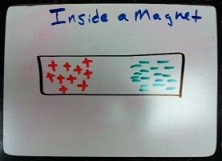
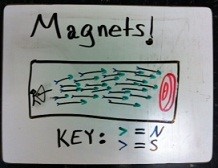
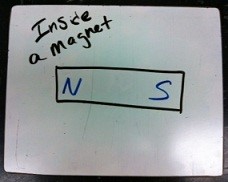
Then, after some discussion and exploration with materials (like magnetizing iron filings in a corked test tube and a long nail that can be cut), have them discuss with groups and whiteboard the question again! Make sure their model accounts for how magnets can't ever just have a North or a South pole (you can't have one without the other . . . why?
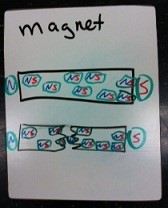
From Physics Education Research:
Students at the college level generally hold the same initial ideas of the inner workings of magnets as ES children. Why?? Mostly because they have not investigated "magnetism" in a systematic way, but also because they have not challenged or discussed with others what they "know" about magnetism. It is really amazing to see a class move toward the domain model (pictured last) from incomplete models while sharing their ideas and laboratory experiences. This level of understanding is attainable among elementary school students! Whiteboarding alone won't do all of this for you, but it certainly can be a huge part!
Where can I get whiteboards?
Making Whiteboards:
Advantages include
- This is an inexpensive alternative to going to a supplier, potentially entirely free
- You may be able to get a local lumber store to donate the boards; especially if you tell them you'll take damaged panels
- You may be able to get your local lumber store to cut the boards for you
- You make them whatever size you want.
- You can include a handle hole wherever you want and how big you want.
- You can include a small hole for a marker/eraser tie if you like.
Disadvantages include
- They take time to make (edges should be sanded and corners should be rounded).
- It may take some expertise to cut them the way you want them.
- Do yourself a favor and wear a mask and/or set up a shop vac!
Options of boards at a local lumber store would likely include
- Dry Erase board
- Comes in 32" x 48"
- Most expensive (~$6 for 32" x 48" panel)
- Frostywhite
- Midrange price (~$14 for 48" x 96" panel)
- Thrifywhite
- Least expensive (~$12 for 48" x 96" panel)
Whichever you choose make sure it is marlite, equivalent or superior. Do not get the thin vinyl shower enclosure material.
Purchasing Ready-Made Whiteboards
Advantages include
- No hassle: purchase what you want and you don't have to spend time making cuts or sanding
- It's now a competitive market, prices are getting pretty reasonable
- Because of the market, many suppliers have added features like diagrams, graphing grids, two-sided boards, etc.
Disadvantages include
- Can get pricey
Suppliers (this is by no means a comprehensive list, but it should be enough to get you started looking)
"The Makerboard People at http://www.dryerase.com/ seem to have excellent prices on tough boards. They have larger 24"x24" boards too that are pretty cool. Many of their boards come pre-printed with graph lines, anatomy pictures, periodic tables, etc. Some are printed on one side but have markerboard material on both sides."--Zeke Kossover
www.whiteboardsusa.com --Frank Noschese
Playscapes (bulk supplier) --Jane Jackson
"Huddle Boards by Steelcase. You might find expanding your search using this term helpful."--Phil Long (This is a high-end product)
Recommended Sizes
24" x 32"
Good size for group work, especially in landscape orientation. Students (once in the habit) can write large enough for whole class to see. This size will fit on most lab tables without taking up too much of a footprint. This is the size that many "modelers" use in physics and math.
9" x 12"
Small and convenient, but . . . This is the minimum size for individual use and will accommodate a sheet of paper. This is really not practical for group work or large classrooms (where you'd want students to see what others wrote from across the room). The good news: an entire class set won't take up much space and can fit in an unused digital projector bag.
There's no doubt about it, these are small. But in a way handy, too. Simple graphs and diagrams can still lead to great discussions. Below, two student groups tried to represent a diagram of high precision but low accuracy . . . How could you lead a class discussion to sort this one out?
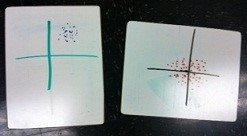
2' x 4'
Great for group work and easy for lumber stores to cut for you. These prop nicely portrait or landscape style in the tray of your wal mounted chalk/marker board. The downside is they are a little awkward for students to move around at this size, especially if you have sinks or gas outlets at your lab tables--it can be difficult to find a large enough level writing surface. Pictured below is a 2' x 4' board being used. There is a lot of room for reporting data, generating graphs and answering questions--large enough for everyone in the class to see. Plus, there's room for artsy diagrams! The example below is just BEGGING for a discussion of slope . . .
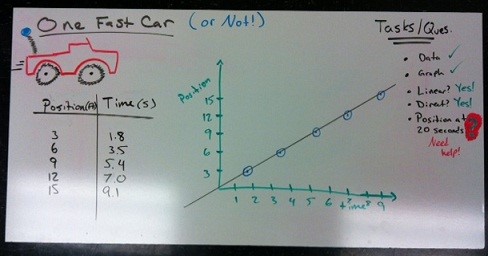
Tricks of the Trade
Perhaps the biggest drawback to using whiteboards is the use of dry erase markers. They can be messy, are a consumable item and are non-renewable. There are alternatives you might not be aware of, however:
- "There are a couple of solutions to yucky pens. They make whiteboard markers that are refillable and use a water based ink. I like the ones made by AusPen . The six pack with refillable six color inks cost $50. Used them for entire year and never needed replacing. They needed refilling about once a week. On the other hand, no dust and the board is far, far easier to erase and clean. New pens cost $1.50. Ink is extra.The nibs wear out and need replacing. I love them." -- Zeke Kossover
- "There are also whiteboard crayons. They require more effort to erase than dry erase markers. I wouldn't use them on my main board, but for small boards they work fine and the crayons don't need capping so they last pretty much forever." -- Zeke Kossover
Helpful hints on buying and maintaining whiteboards -- Jane Jackson
Whiteboard care & cleaning (compiled listserv discussion from ASU's modeling website)
Propping whiteboards up in the tray of the chalkboard/markerboard in the front of the room helps students see them all at once. You may even be able to prop them up on the upper frame of the chalkboard/markerboard. Alternatively, whiteboard stands can be purchased/made (for larger whiteboards). Guitar hangers could also work. . .
Chalkboard paint can be added to the back of an economy board for using chalk. -- Jim Deane
If you (or your students!) are tech-savvy, even smartphones or iPads can be used as "mini" whiteboards:
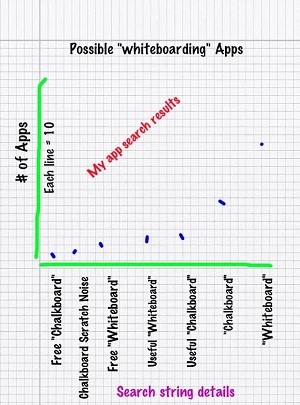
Above is a screen capture of a graphic created with the Doodle Buddy on an iPhone. In this example, the numbers of apps resulting from searches were plotted. While this is done in tongue-and-cheek (the implied exponential trend is meaningless), it does demonstrate how text can be inserted, rotated and graphs generated. This particular app is free and has limited but useful features.
Supporting References
Multimedia Resources
- Blog by Frank Noschese: The $2 Interactive Whiteboard
- Videos demonstrating best practices & utility of whiteboarding
Select publications on whiteboarding effectiveness
(from Arizona State University's modeling site thank you, Jane Jackson!)
- Modeling Discourse Management -- Doctoral dissertation, Dwain Desbien (2002)
- Rules of the whiteboard circle -- John Griffith (2011)
- Whiteboarding in the college and HS classroom -- Dan MacIsaac
- Using interactive whiteboarding to enhance student learning -- Patty Blanton (2008)
- Whiteboarding: a learning process -- Don Yost (2003)
- Whiteboarding and Socratic dialogues: Questions and answers -- Carl Wenning (2005)
- Engaging students in conducting Socratic diologues: Suggestions for science teachers -- Carl Wenning (2006)
You will soon learn that "whiteboarding" is less about having a white board and more about questioning strategies. As you get a handle on how whiteboards can enhance the classroom, you'll find yourself digging deeper into questioning strategies . . .
Other references (thank you, Paul Camp!)
- Barrows, H.S. (1996). Problem-based learning in medicine and beyond: A brief overview. In Wilkerson, L & Gijselaers, W.H. (eds). New directions for teaching and learning, no.68. Bringing problem-based learning to higher education: Theory and practice, 3-13. San Francisco: Jossey -Bass
- Principles and Practice of aPBL Howard S. Barrows and Wee Keng Neo
- Hmelo, C.E. & Evensen, D.H. (2000). Problem-based learning: Gaining insights on learning interactions through multiple methods of inquiry.
- In Evenson, D.H. & Hmelo, C.E. (eds). Problem-Based Learning: A Research perspective on learning interactions, 1-18.
- Problem-Based Learning: How to Gain the Most from PBL by Donald Woods McMaster University (1994) ISBN - 9780666239617
- Research based and an indepth publication on the implications for curriculum; using whiteboards is a component of activity the authors have students engaged in.
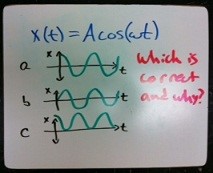
Listserv Compilations (Helpful discussions from the ASU modeling listserv)
- Whiteboarding: A tool, a learning experience
- Whiteboarding: Board meeting introductions
- Whiteboarding: Board meeting physical aids
- Whiteboarding: Board meetings -- speed the pace
- Whiteboarding: Identify the model!
- Whiteboarding: Appropriate use of data tables
- Whiteboarding: Resistance by lower-level students
- Whiteboarding: Ways to improve
Ask students to create questions they would expect to see on your next exam. You will be surprised . . . Above is a sample wave behavior question.
Thank You!
This project would not have been successful without the following support, so Thank You!
- Oklahoma State Regents for Higher Education for funding the project
- Brian Lamore for brainstorming about the idea
- ToPPS 2011 participants for chiming in with feedback about what kind of “thing” would have the most impact
- Merrifield’s of Alva for discount on markers
- Starr Lumber of Alva for donating labor, equipment usage and time (5 hours straight of cutting panels!)
Volunteers:
• Tim Maharry, cutting (mathematics)
• Richard Ryerson, ordering, cutting—manning the saw (Starr Lumber)
• Dean Scarborough, cutting (agriculture)
• Steve Thompson, cutting (biology)
• Jason Wickham, cutting (chemistry) and
• Amber, Leah (11), Jenna (8) & Kayla Maier (3) were my packers! *Disclaimer: Counts on items are +/- 2 due to Kayla’s help--uncertainty would be greater if only Steve did the counting!